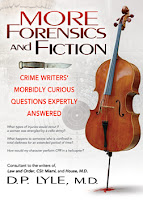by Andrea Campbell
I have conducted a few interviews with my friend and colleague, Doug Lyle, M.D. Each of his books that have been sent to me to review has set forth promises for the reader and, in my estimation, all expectations have been met. That's why I was happy to receive his latest book, a research title for writers (and lovers of writers and fiction) called More Forensics and Fiction.
Now Doug, also professionally known as D.P. Lyle, M.D., has also acted as a consultant and advisor on various television shows like Law & Order, CSI: Miami, Monk and House, so I know he is adept at research and his medical background makes him one of the best.
Now Doug, also professionally known as D.P. Lyle, M.D., has also acted as a consultant and advisor on various television shows like Law & Order, CSI: Miami, Monk and House, so I know he is adept at research and his medical background makes him one of the best.
Doug also has a web site, The Writer's Forensics blog, that has provided more than enough material for this latest book--due out in April--and has also well-supplied two previous titles, Murder and Mayhem: A Doctor Answers Medical and Forensic Questions for Mystery Writers, and the second, Forensics and Fiction: Clever, Intriguing, and Downright Odd Questions from Crime Writers. In these volumes, Dr. Lyle answers questions, forensic questions, yes--but more interesting, questions from fiction writers and authors who need to add verisimilitude to their stories, and who can't afford to create scenarios unless they are right. Consequently, this makes for a lot of screwy and somewhat "out there" criminal plotting, and also reflects on the type of creative sketches and stretches of the imagination and that makes this book two-fold: a research vehicle and an interesting read.
There are no "typical" questions as these are forming the basis of fictional stories that involve crime and essentially made-up situations. The questions are however, broken up into parts such as: Traumatic Injuries, Illnesses, Doctors and Hospitals in Part 1, to another part such as: The Coroner, the Body and the Autopsy in Part IV, and, what could be my favorite and final section Odds and Ends, Mostly Odds making up Part V. And, of course, one of the fun parts is that these questions come from storytellers both famous and not, whose goal it is to want their readers to turn the page, so some of them are truly "out there."
There are no "typical" questions as these are forming the basis of fictional stories that involve crime and essentially made-up situations. The questions are however, broken up into parts such as: Traumatic Injuries, Illnesses, Doctors and Hospitals in Part 1, to another part such as: The Coroner, the Body and the Autopsy in Part IV, and, what could be my favorite and final section Odds and Ends, Mostly Odds making up Part V. And, of course, one of the fun parts is that these questions come from storytellers both famous and not, whose goal it is to want their readers to turn the page, so some of them are truly "out there."
Just to illustrate a few of the questions inside More Forensics and Fiction: Will snake venom injected into fruit cause death? What happens when someone swallows razor blades? and Can DNA be obtained from a half-eaten bagel?
And actually, here is a partial answer to a particular question and it is also related to one of my pet peeves (I will explain after): "Do teeth and their fillings remain in a skull twenty years after death? A.: Actually, the teeth often fall from the skull and jawbone. This is due to decay of the gum and the socket tissues that anchor the teeth in place. It depends on the degree of decay and how long after death the skull is found. You can construct your story either way..."(and so on).
As for my own pet peeve, how can someone find an ancient skull and the lower part, the mandible, is still attached? "In decayed bodies, the mandible becomes detached from the skull as the temporomandibular joint and supporting ligaments deteriorate," yet we often see the skull with the jaw attached, even after discovery of years!
More Forensics and Fiction, by D.P. Lyle, paperback, 432 pages, Medallion Press, April 2012.
























2 comments:
Having pestered Dr. Lyle with many questions over the years, I look forward to this book, not only for the usefulness of the information but to see if I'm in it.
Jim Keane
writing as JMK758 on FanFiction.Net
I was fortunate to meet our local medical examiner at an event and he gave me some interesting info on DNA for my last book. This sounds like a much more detailed book than the Writer's Digest ones that I have used in the past and one I'll be getting for my book shelf.
Ann
Post a Comment